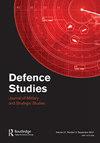NATO burden-sharing: past, present, future
Q1 Arts and Humanities
引用次数: 4
Abstract
ABSTRACT How can NATO upgrade its understanding of (and metrics for) fair burden-sharing? Alliance burden-sharing is a lasting concern for the North Atlantic Treaty Organization (NATO) and will remain a focal point of the NATO 2022 Strategic Concept. Public discussions of NATO burden-sharing and the 2014 Defense Investment Pledge overemphasize defense expenditure and fail to account for alternative frameworks for understanding alliance burden-sharing and specifically, NATO’s optimal burden-share distribution. The U.S. Military Academy’s February 2022 NATO Strategic Concept Seminar featured a panel on burden-sharing frameworks and metrics. In this article, we present the main ideas and arguments, placed within the existing literature on alliance burden-sharing. We argue that, in the long-run, NATO can develop more fair, effective, and efficient burden-sharing arrangements by encouraging weapons and capability specialization, increasing inexpensive but influential operations such as advisory missions, and adapting flexible command and control structures when partnering with non-NATO actors on future battlefields. We argue that, in the short-run, NATO can refine the Defense Investment Pledge with a balanced focus on Cash, Capabilities, and Contributions while also extending the deadline for complete compliance with existing expenditure benchmarks until 2030.北约的责任分担:过去,现在,未来
摘要北约如何提升对公平分担负担的理解(以及衡量标准)?联盟负担分担是北大西洋公约组织(NATO)长期关注的问题,并将继续成为北约2022年战略构想的焦点。关于北约负担分担和2014年国防投资承诺的公开讨论过于强调国防开支,没有考虑到理解联盟负担分担的替代框架,特别是北约的最佳负担分担分配。2022年2月,美国军事学院的北约战略概念研讨会举办了一个关于负担分担框架和指标的小组讨论会。在本文中,我们提出了现有文献中关于联盟负担分担的主要观点和论点。我们认为,从长远来看,北约可以通过鼓励武器和能力专业化,增加廉价但有影响力的行动,如咨询任务,以及在未来战场上与非北约行为者合作时调整灵活的指挥和控制结构,来制定更公平、有效和高效的负担分担安排。我们认为,从短期来看,北约可以完善国防投资承诺,平衡关注现金、能力和贡献,同时将完全遵守现有支出基准的最后期限延长至2030年。
本文章由计算机程序翻译,如有差异,请以英文原文为准。
求助全文
约1分钟内获得全文
求助全文

 求助内容:
求助内容: 应助结果提醒方式:
应助结果提醒方式:


